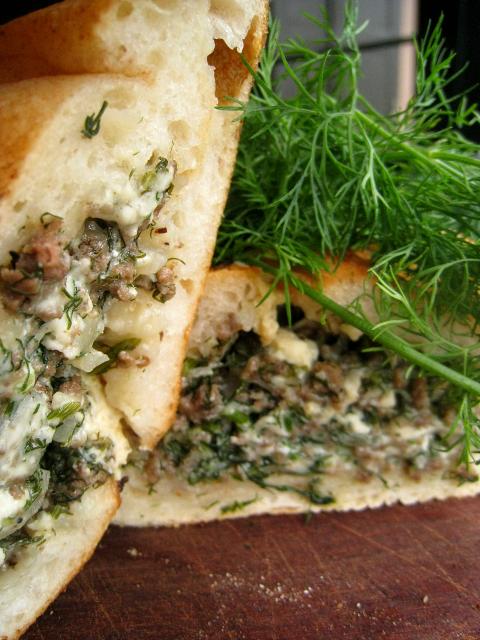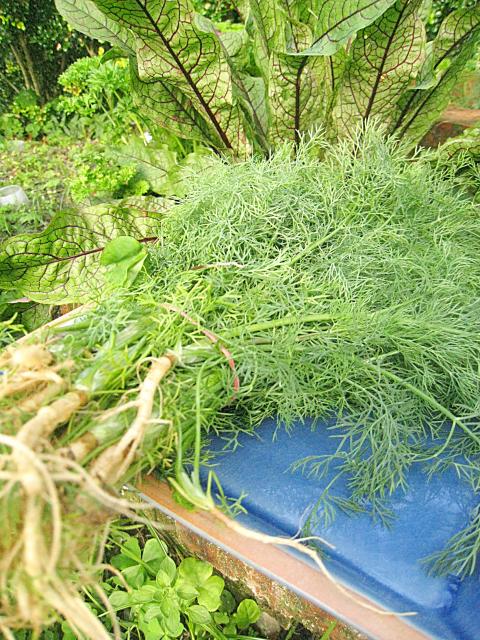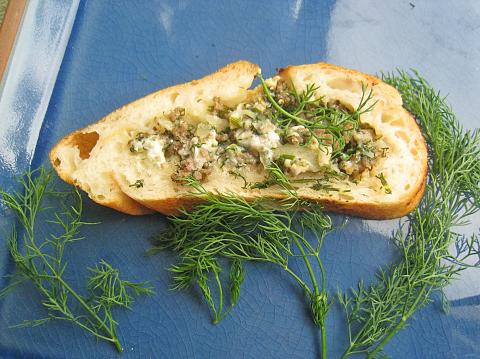When we think about fennel in Western cooking, it is usually as a bulb vegetable. In Taiwan, this type of fennel is unusual and relatively expensive. On the other hand, varieties of fennel cultivated only for the fronds, which are usually removed before sale from the bulb variety, are widely available. While this vegetable is outside the mainstream of Taiwan’s culinary heritage, it can often be found at traditional markets during the winter months and is the vegetable that’s used in beef and fennel dumplings (水餃) served as a cold weather specialty at some specialist northern-style dumpling outlets.
It is interesting to note that many Western culinary Web sites will point out that fronds and leaves of fennel don’t have to be discarded into the compost, suggesting that use of these perfectly tasty and nutritious parts of the plant have fallen victim to commercial demands for easy handling and extended shelf live. While fennel bulbs keep well in the fridge, fronds wilt easily. As with beetroot, (see page 12, Taipei Times, 31 Jan., 2015) it is the long-lasting bulb that is valued, and the leaves, which require to be processed immediately after harvest if they are to be used, are simply discarded and seldom appear in the vegetable market.
Speaking with local farmers and gardening enthusiasts in Hualien, there is a consensus that bulb fennel does not grow easily in Taiwan, or certainly not without specialist techniques, and the bulb varieties that are cultivated tend to be rather flat, rather than acquiring the fully developed bulb that is so common in the West. On a visit to my local farmers market last year, one stallholder was eager to sell me a bag of rather malnourished bulb fennel, though freely admitting that she really didn’t have any idea how it should be prepared. As a foreigner, clearly she expected me to know what to do with these otherwise unpopular products. (Braised with bacon and other vegetables, they make an uncommonly tasty warm salad that is perfect for the cold weather.)

Photo: Ian Bartholomew
So while fennel, as a plant, does not seem to feature prominently in Chinese cooking, it does contribute more than most people realize, though in other forms. Ground fennel seeds are an integral part of the ubiquitous five-spice powder (五香粉) that features in such a wide variety of Taiwanese cooking. This spice commonly contains star anise, cloves, cinnamon and Sichuan pepper as well (and may include much more that just five items), and provides a distinctive flavor to anything from dried tofu to stewed pork.
But getting back to fennel tops. Bought fresh, the fronds are wonderfully aromatic and can add a splendid boost of flavor simply thrown into a salad with a variety of other leaves, apples, nuts and cheese. While dill, a plant that is often confused with fennel, is most famously used for the curing of salmon in the form of the northern European dish gravlax, fennel stems and fronds are a great accompaniment for salmon in a wide variety of other preparations. Salmon fried with crushed fennel seeds, and optionally with the addition of a splash of pastis, is one of my favorite quick and easy suppers, with most of the flavor coming out of the spice drawer and the liquor cabinet. While many will insist that dill and fennel taste very different and cannot be substituted for one another, my own experience, especially given a preference for fresh local over imported (in the case of dill), is that there is a substantial overlap where a loss of authenticity is completely justified.
Fennel, with its hints of licorice, is a perfect winter herb. It doesn’t have the intensity of anise, but at the same time, leaf fennel, certainly in the variety widely available in Taiwan, has a much more powerful flavor than fennel bulbs. While some Web sites recommend using fennel stems and fronds to make a pesto, the strong flavor of the Taiwan variety does not suit this preparation. It is much better as an adjunct to other strong flavors.

Photo: Ian Bartholomew
Fennel, like other members of the Umbellifereae family, which includes parsley, carrots, dill and coriander, is chock-full of healthful benefits, most notably a powerful antioxidant function. In Chinese medicine, it is regarded as helpful in reducing pain, especially due to intestinal problems or poor digestion. It is widely revered in Chinese medicine and Mediterranean cuisine and is used in such digestif drinks as Ouzo (in Greece) and Absinthe (France). As a peripheral vegetable, it is generally quite cheap and provides loads of flavor, and while the fresh variety is in season, it is well worth putting it to use.
Beef and fennel-stuffed bread
Recipe (serves four)

Photo: Ian Bartholomew
The perfect picnic bread, this combines meat, vegetables and melted cheese wrapped inside a French bread casing, providing a complete meal in a convenient package. Leaf fennel has quite a strong flavor, and balances better with beef rather than pork. The meat filling, if you are feeling lazy (as I often do), is perfect over white rice, or served as a kind of offbeat meat sauce with spaghetti.
Ingredients
- 500g ground beef
- 200g fennel tops (leaf fennel), finely chopped
- 1/2 an onion, finely diced
- Salt and pepper
- 50g feta cheese
- 50g Grana Padano, grated (Gruyere or Emmental also work well)
- 2 eggs, lightly beaten
- Olive oil
- Lean bread dough, or commercial pizza base
Directions
1. Season the beef generously with salt and pepper.
2. Heat a pan with about 2 tablespoons of olive oil and brown the meat, preferably in two batches. (Add more oil if required.) Remove the cooked meat and set aside.
3. Using the same pan, add the finely chopped onion and cook until translucent, about 5 minutes, scraping up any bits of meat that stuck to the bottom of the pan during the browning process.
4. Return the meat to the pan and add the fennel, and cook for about 2-3 minutes over medium heat or until dry. Remove from heat.
5. Crumble the feta cheese into the mix, then add the Grana Padano and egg. Mix well.
6. Roll out the dough into a large disk (about 6-8 inches), and place the filling on half of the disk. Use any remaining egg, or water, to wet the edge of half the dough and fold over, pressing down to seal.
7. Cut two or three slits at the top. Place on a heavy baking sheet or slide onto a baking stone in a preheated oven of 230c. Cook for 25 minutes.
8. Remove and allow to cool for at least 10 minutes before serving.
Ian Bartholomew runs Ian’s Table, a small guesthouse in Hualien. He has lived in Taiwan for many years writing about the food scene and has decided that until you look at farming, you know nothing about the food you eat. He can be contacted at Hualien202@gmail.com.

Taiwan Power Co (Taipower, 台電) and the New Taipei City Government in May last year agreed to allow the activation of a spent fuel storage facility for the Jinshan Nuclear Power Plant in Shihmen District (石門). The deal ended eleven years of legal wrangling. According to the Taipower announcement, the city government engaged in repeated delays, failing to approve water and soil conservation plans. Taipower said at the time that plans for another dry storage facility for the Guosheng Nuclear Power Plant in New Taipei City’s Wanli District (萬里) remained stuck in legal limbo. Later that year an agreement was reached

What does the Taiwan People’s Party (TPP) in the Huang Kuo-chang (黃國昌) era stand for? What sets it apart from their allies, the Chinese Nationalist Party (KMT)? With some shifts in tone and emphasis, the KMT’s stances have not changed significantly since the late 2000s and the era of former president Ma Ying-jeou (馬英九). The Democratic Progressive Party’s (DPP) current platform formed in the mid-2010s under the guidance of Tsai Ing-wen (蔡英文), and current President William Lai (賴清德) campaigned on continuity. Though their ideological stances may be a bit stale, they have the advantage of being broadly understood by the voters.

In a high-rise office building in Taipei’s government district, the primary agency for maintaining links to Thailand’s 108 Yunnan villages — which are home to a population of around 200,000 descendants of the Chinese Nationalist Party (KMT) armies stranded in Thailand following the Chinese Civil War — is the Overseas Community Affairs Council (OCAC). Established in China in 1926, the OCAC was born of a mandate to support Chinese education, culture and economic development in far flung Chinese diaspora communities, which, especially in southeast Asia, had underwritten the military insurgencies against the Qing Dynasty that led to the founding of

Artifacts found at archeological sites in France and Spain along the Bay of Biscay shoreline show that humans have been crafting tools from whale bones since more than 20,000 years ago, illustrating anew the resourcefulness of prehistoric people. The tools, primarily hunting implements such as projectile points, were fashioned from the bones of at least five species of large whales, the researchers said. Bones from sperm whales were the most abundant, followed by fin whales, gray whales, right or bowhead whales — two species indistinguishable with the analytical method used in the study — and blue whales. With seafaring capabilities by humans